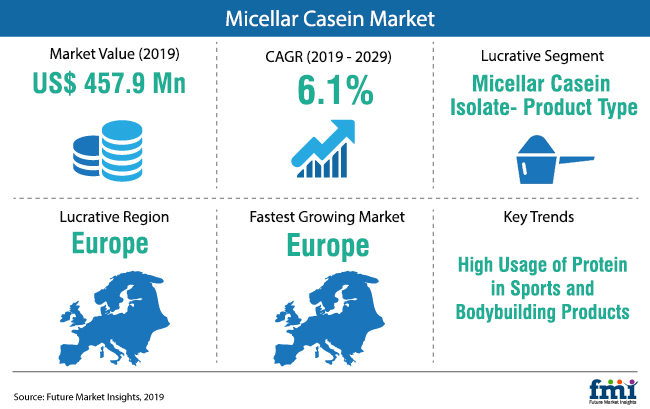
Dairy-deficit Regions Driving Imports of Micellar Casein
In sharp contrast to its demand, milk is not uniformly produced across the globe, leaving a large number of countries with a dairy deficit. This deficit, in turn, leads to high imports of dairy ingredients such as micellar casein from regions such as Australia, New Zealand, the US, and the EU. The impact of this deficit and the level of imports are particularly high in various emerging economies such as China, Indonesia, Mexico, and Russia.
Opportunity for the growth of the micellar casein market is also mediated through imports as China happens to be the largest importer for dairy products and dairy ingredients.
Increasing Use of Micellar Casein in Fresh Dairy Products and Beverages
Competitors in processed dairy products are banking on the quality of their products. Micellar casein is well-fitted with texture and taste reforming characteristics which enhance quality. Apart from its high, natural protein content, micellar casein also offers a neutral taste that preserves the original taste profile of these processed products. Micellar casein provides uniform texture that is almost similar to that of milk. Hence, the quest to deliver better quality products is also driving the growth of the micellar casein market.
Nutritional beverages contain added nutrients and generally rely heavily on claims made by end-product manufacturers and the benefits offered by the natural, additive-free nature of micellar casein. Hence, fortified beverage offerings represent another segment where micellar casein market is foreseen to witness high growth.
Advanced Technology-enabled Easy Manufacturing Techniques Gaining Preference
Micellar casein is separated from milk using various membrane filtration methods, which is a relatively new technology that enables the production of un-denatured proteins that are free from any chemical processing or additives. The commonly used membrane filtration methods used for the production of micellar casein include microfiltration, ultrafiltration, nanofiltration, and reverse osmosis.
The use of ultrafiltration is particularly high in the production of micellar casein. Ceramic membranes, with pore sizes ranging from 0.1 to 0.2 µm, are the most commonly used membrane type for filtration of micellar casein. These processes provide several benefits to producers, as they avoid denaturing of the protein, thereby allowing cost-effective production of native proteins.
E-commerce Expanse to Benefit Smaller Manufacturers in Micellar Casein Industry
The adoption of directly consumable micellar casein is also on the rise. Online platforms enable consumers to access various new ingredients such as protein isolates and micellar casein, 24/7, globally. The analysis suggests that the flourishing online platforms will create a heap of profitable opportunities for Small-scale micellar casein manufacturers, which otherwise are facing several market entry barriers, particularly pricing pressure and high marketing costs.
Severe Competition from Other Protein Ingredients
Micellar casein is relatively new and as such faces intense competition from dairy-based, animal-based, and plant-derived protein ingredients. Micellar casein is relatively more expensive than other milk proteins, which may compel food manufacturers to opt for cheaper alternatives. This, coupled with a growing interest in natural or plant-derived proteins such as pea protein, is a factor expected to restrain the growth of the global micellar casein market to a certain extent over the forecast period.
The other aspect of this competition is the high similarity between milk protein concentrate/isolate and micellar casein. Both products are produced by membrane filtration methods and contain almost similar amounts of casein but differ in the presence of whey proteins.
Owing to high quality and unique preparation method, micellar casein is expensive than other dairy ingredients, which may negatively impact the growth of the market in the long run, particularly for end-use manufacturers based in emerging economies.
The report on global micellar casein market covers in-depth strategic profiles of some of the most prominent players, including ProteinCo, Idaho Milk Products, Inc., Milk Specialties Global, AMCO Proteins, Ingredia SA, Nutrimed Healthcare Private Limited, FrieslandCampina Domo, Nutrend D. S., and Freedom Foods Group Limited.
These insights are based on a report Micellar Casein Market by Future Market Insights

























